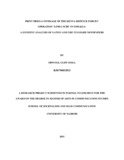| dc.description.abstract | War coverage has since time immemorial been a challenge due to its complexity. From previous
wars, reporting has been a challenge in the sense that the media rely a lot on news given out by
the combat forces. In the Kenyan case, the Kenya Defence Force was engaging in a maiden
international war. Similarly, the Kenyan media were engaging in the first international war
coverage. The principal objective of this study was to determine the manner and extent to which
print media covered the Kenya Defence Forces incursion on Somalia, otherwise dubbed
Operation ‗Linda Nchi‘. The study will also seek to establish who or what the sources of news
were during the operation. The study also sought to find out techniques used by the media and
also to find out if the media made the audience believe in the conduct of Operation ‗Linda Nchi‘
in Somalia. The following theories were used: the theory of agenda setting, gatekeeping theory
and the propaganda theory. Content analysis research methodology was used. The study was
confined to a content analysis of two leading newspapers in Kenya, the Daily Nation and The
Standard. The key findings of this study were that the media relied a lot on news from
Government agencies instead of residents and eyewitnesses accounts of the combat in Somalia.
The study recommends the need for media houses to train and deploy independent journalists for
the sole purpose of gathering news independent of the official Government sources. This is so
because, if they rely on Government agencies for news, then it will be in the whims of these
agencies to release any news and to have reporting done the way they (agencies) want it done. It
was also found that most news were done and reported from Kenya. Very little reporting was
done from Somalia which raised the issues of credibility of the news presented to the public. The
media were embedded in the troops and so opted to remain in the tactical centres rather than
venturing out in the live combat areas. The study thus recommends the need to get facts from the
ground of the operation. Further, the study recommends that much needs to be done in terms of
training and equipping journalists to beef up war reporting in Kenya bearing in mind that the
Kenyan media was exercising a maiden responsibility since the Kenyan troops had never gone to
war with another nation before. | en_US |

